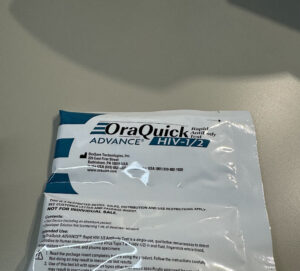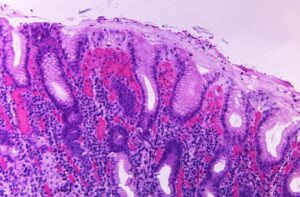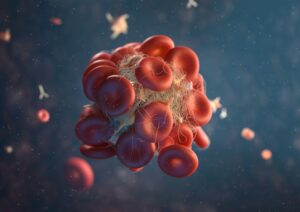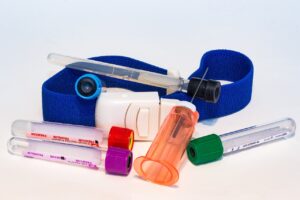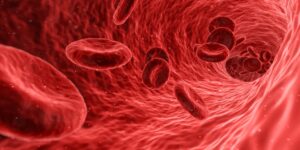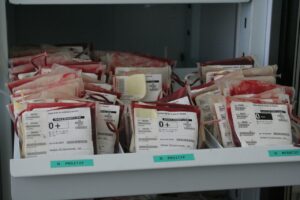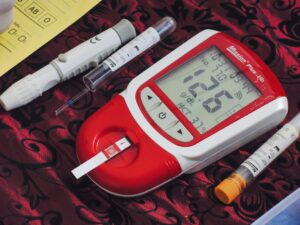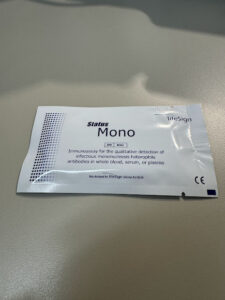
What Is Mono?
Infectious Mononucleosis (IM), widely known as “mono”, or “kissing disease”, is an acute disease of the lymphatic system. It is most commonly caused by the Epstein-Barr virus (EBV), but other viruses can cause it as well. It is most common among teenagers and young adults.
Diagnosis of mono is typically based on the presence of clinical, hematological, and serological manifestations.
-Clinical signs include fever, fatigue, pharyngitis, and enlargement of head & neck lymph nodes for a period of 1 to 4 weeks.
-Hematologic signs include lymphocytosis and atypical lymphocytes visualized on a stained blood smear.
-Serological signs are demonstrated by the presence of heterophile and EBV antibodies in the patient’s blood. This is where mono testing comes in.
If you want to learn how to test for mono, we will walk you through the steps below as I perform the test with a rapid kit. Pictures will be included for visual aids during each step.
How Long Does A Rapid Mono Test Take?
This will depend on the type of test kit that is used, but among the most popular brands in use today, most will use either a 5 minute or 8 minute time frame at which the results can be read.
Test Principle
Status Mono is a rapid mono test made by LifeSign LLC. We will use this test kit to demonstrate the performance of the rapid mono test procedure. These types of tests use immunoassay technology for the qualitative detection of IM heterophile antibodies in human serum, plasma or whole blood.
If any IM-specific heterophile antibody is present in the sample, it will be captured by the antigen band impregnated in the test membrane and will mobilize the dye conjugate to form a line, signifying a positive result.
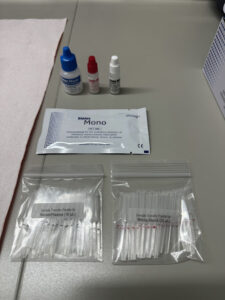
Specimen Collection
– Whole Blood/Plasma: if using whole blood or plasma, it must be anticoagulated with CPDA-1, heparin or EDTA. A purple top EDTA tube is the most commonly used. For plasma, the blood should be centrifuged at 1500xg for 10 minutes. For whole blood, it does not require centrifuging.
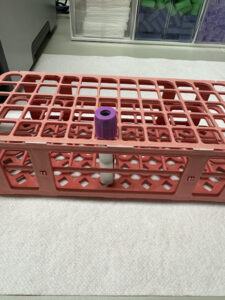
– Serum: no anticoagulant should be used for serum samples. Draw blood into a tube with no additive and let it clot. Once clotted, centrifuge at 1500xg for 10 minutes.
– Fingertip blood: prick the finger and allow a free-flowing drop to form. Wipe away the first drop and collect the second drop of blood that forms. Fingerstick blood is considered whole blood, which is why the 25µL volume pipette is used to collect sample from the finger.
Rapid Mono Test Procedure
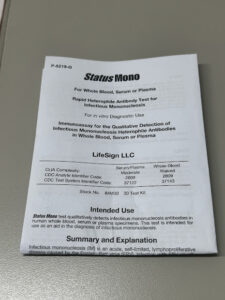
STEP 1
Remove a test device from its pouch and place on a flat surface.

STEP 2
Collect the sample using the appropriate sample transfer pipette according to the volume of sample required. Use the 25µL (red line) sample transfer pipette for whole blood or the 10µL (black line) sample transfer pipette for serum/plasma samples. Hold the sample transfer pipette horizontally and touch the tip of the pipette to the sample. The pipette has a hole in the wall which helps with air venting and sample volume control. Filling is automatic, so you do not need to squeeze while filling the pipette. It will stop filling automatically once it hits the fill line.

STEP 3
Align the tip of the pipette over the upper area of the test device sample well and squeeze the bulb to expel the specimen. If the sample won’t come out, place a finger over the vent hole and then try squeezing again to help force it out.
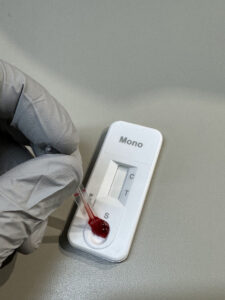
The transfer pipettes that come with the kit can be tricky to use and honestly, not very effective. A better option is to use a fixed or variable volume pipette with disposable tips similar to what is shown in the image below. These need to be set to either 25ul or 10ul, depending on the specimen type. This makes for a more frustration free pipetting experience and ensures that the proper quantity of sample is delivered to the sample well. These do not come with the kit and must be purchased separately.
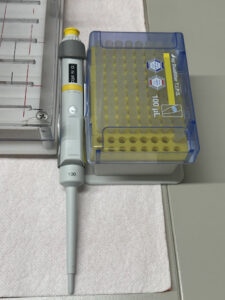
STEP 4
Add 2-3 drops of Developer Solution into the lower area of the Sample Well.
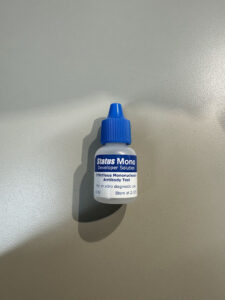
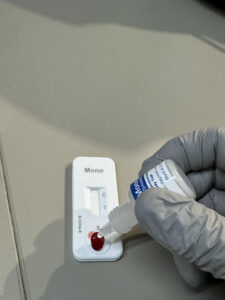
STEP 5
Set a timer. Read the results no sooner than 8 minutes, but no later than 15 minutes.
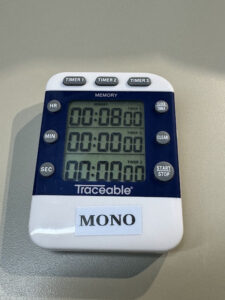
STEP 6
Interpretation of Results
a. Positive
One pink-purple colored horizontal band at the Test position (T) and at the Control position (C) indicates that the test is positive.
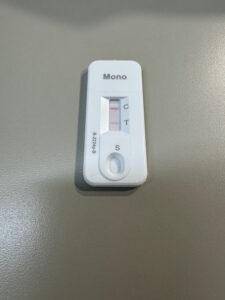
b. Negative
One pink-purple colored horizontal band at the
Control position (C), with no colored band at the Test position (T) indicates a negative result.
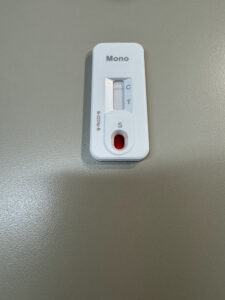
c. Invalid
If no band forms at the Control position (C), the test is considered invalid and must be repeated.
Quality Control
External quality control (QC) materials should be used at regular intervals in order to ensure the kit is working properly. These time intervals will be dictated by local SOP. External QC consists of separate positive and negative controls. Instead of putting patient sample inside the sample well, one drop of each should be placed on 2 separate devices and then read just like a patient. If either one does not react as it should, there is either a flaw in the materials or a flaw in technique.
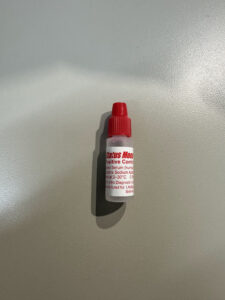
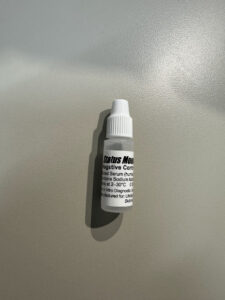
FDA Complexity
Under the 1988 CLIA regulations which governs the qualifications of lab testing personnel, the Status Mono kit is classified as “Moderate Complexity” for plasma and serum samples. If using whole blood samples, it is classified as “Waived”.
Specificity & Sensitivity
A highly specific test is less likely to give a false positive due to its ability to rule out patients who do not have the disease, but are showing similar symptoms which are possibly a different disease.
A highly sensitive test is less likely to give a false negative result, due to its superior ability to measure low concentrations that might be below the cutoff of other methods.
According to studies carried out by Status Mono, their kit demonstrated a relative specificity of 98.8% and a relative sensitivity of >99.9%. Considering these results, this kit is regarded as very accurate.
How Soon Can Mono Be Detected?
Usually after about 3 weeks from becoming infected, approximately 80-85% of people will test positive. Antibody levels will typically drop off after the 4th week of infection.
In some cases, it can take longer than 3 months to develop a level high enough to be detected.
Rarely, some patients have reported maintaining low antibody levels even after the illness is over and still testing positive for more than 1 year after onset.
Can Anything Else Cause A Positive Mono Test?
The IM heterophile antibody has been associated with disease states other than mono, such as leukemia, cytomegalovirus, Burkitt’s lymphoma, rheumatoid arthritis, adenovirus, viral hepatitis, and Toxoplasma gondii. EBV-specific laboratory methods may be necessary for confirmation in some of these cases.
Conclusion
Medical providers use clinical, hematological and serological evidence when considering a diagnosis for infectious mononucleosis. Lab testing with rapid kits like the one demonstrated above are not very resource or time intensive, but they still give valuable information to the serological side of the workup.
References
Status Mono. (n.d.). Retrieved from Lifesign Med: https://www.lifesignmed.com/sites/default/files/Status%20Mono%2068364%20Package%20Insert.pdf


